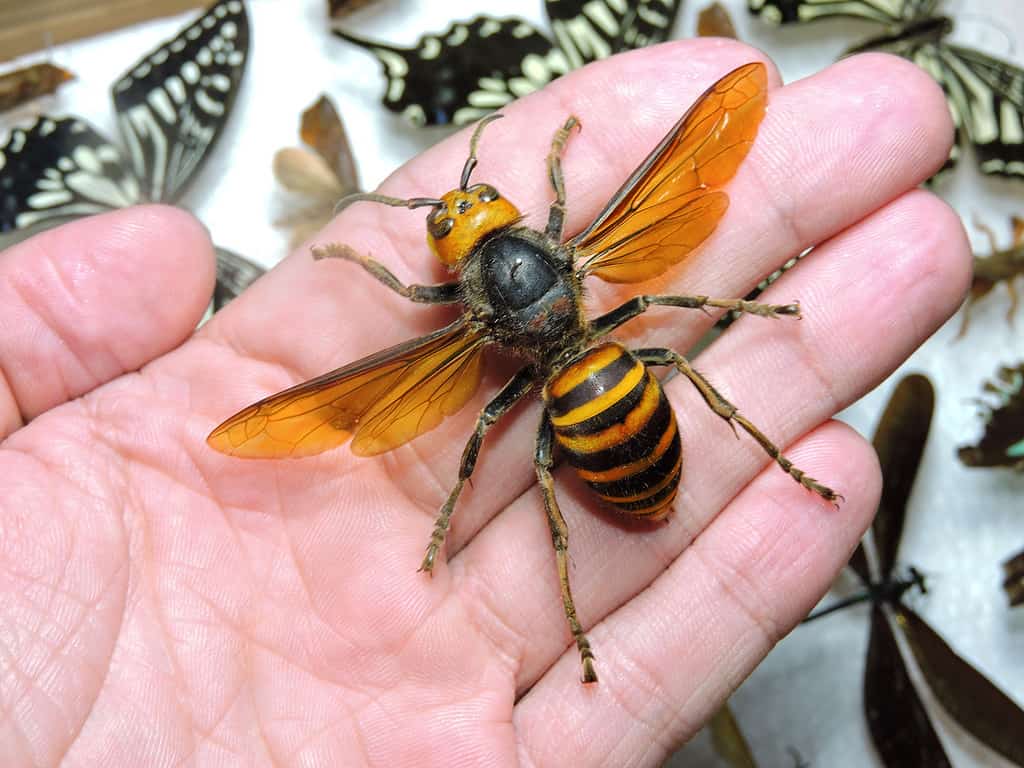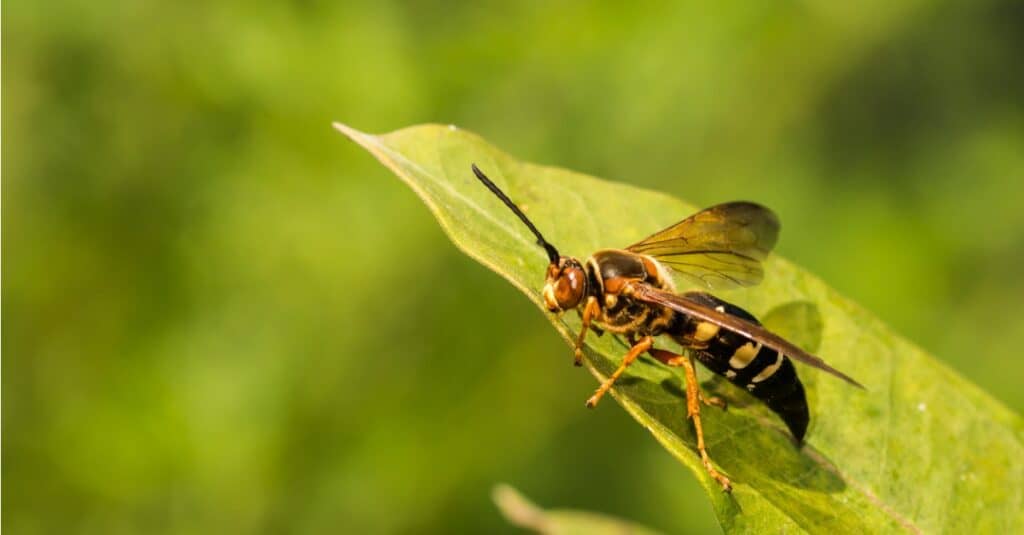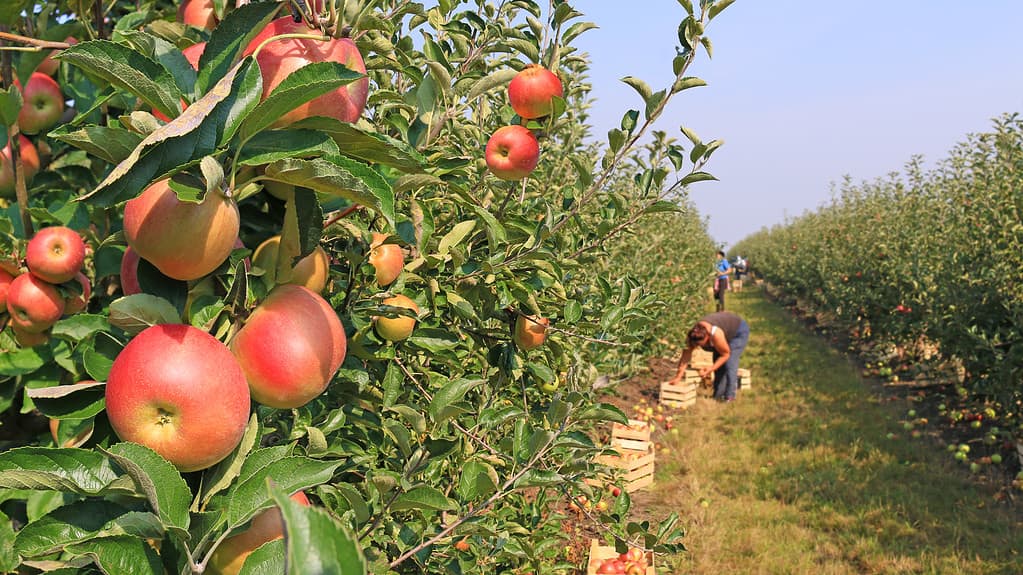There has been a lot of confusion lately when it comes to recognizing the differences between the cicada killer wasp and the Asian giant hornet. At first glance, these two insects look almost identical. Throughout North America, tons of people have been reporting seeing the Asian giant hornet, also known as “murder hornets.” It makes sense that many people would be confused between these two bugs when they’re rapidly buzzing around you. However, in order to ease your fears, it helps to know the difference between these two insects. We’ll explore the main differences when comparing the cicada killer wasp vs. the Asian giant hornet.
By the end of this article, you should be able to confidently distinguish these two insects from one another!
Comparing a Cicada Killer Wasp and an Asian Giant Hornet
| Cicada Killer Wasp | Asian Giant Hornet | |
|---|---|---|
| Scientific Name | Sphecius speciosus | Vespa mandarinia |
| Size | 1.5 to 2 inches | 1.5 to 2 inches |
| Lifespan | Males live for about two weeks while females live for about four weeks | Three to five months |
| Appearance | Black or dark brown in color with yellow markings on different parts of their body | Orange-yellow heads with large eyes along with orange and black stripes on their body. |
Cicada Killer Wasp vs. Asian Giant Hornet: Size and Appearance

The Asian giant hornet has dark orange and black stripes.
©iStock.com/Bruno Uehara
Let’s start off by explaining the main differences between the cicada killer wasp and the Asian giant hornet in terms of appearance. It’s easy to see why most people will easily misidentify these two insects for one another. The biggest similarity between these two is their overall size. They both grow to an average of 1.5 to two inches. Additionally, these two insects also share a similar wing color as they both sport amber-colored wings. However, this is where the similarities stop.
The easiest way to tell the difference between these two insects is in their coloring. The cicada killer wasp is actually the largest wasp in the world. Their bodies are either black or dark brown in color. They then feature yellow markings throughout their abdomen. This is quite different from the Asian giant hornet whose body features dark orange stripes. The shape of their stripes also differs as well. The stripes on an Asian giant hornet can be best described as smooth bands on their bodies. Meanwhile, the cicada killer wasp has stripes that are not perfectly banded around them.
Finally, their heads are also quite different. The cicada killer wasp has a narrow head that is the same dark brown or black color as its thorax. The Asian giant hornet, in comparison, has a much larger head. In fact, their heads are often wider than their shoulders. They are also an orange color, and they don’t blend in with the color of their thorax. Next, let’s find out more about the native ranges of these two insects.
Cicada Killer Wasp vs. Asian Giant Hornet: Native Range

The cicada killer wasp is the largest wasp in the world.
©Ryan Silva/Shutterstock.com
So how do these two insects vary in their native range? Well, the eastern cicada killer wasp is present throughout the eastern United States and parts of the eastern Rocky Mountains. The western cicada killer wasp is known to reside in Texas, California, and even Nebraska and Washington State. These species can also be found in Mexico and Central America. They mostly come out during mid-late summertime.
Asian giant hornets, on the other hand, are not native to the United States. Instead, their native range is the more tropical parts of East Asia, South Asia, and the mainland areas of Southeast Asia. There are even parts of Far East Russia where these hornets are found. However, back in 2019, there were reports of this insect spotted in the Pacific Northwest of North America. Then in 2020, more people began to report Asian giant hornet sightings. Eventually, in 2021, there were some nests found, and officials began to worry that an invasive species may be establishing themselves in the states. However, by 2022, there were no real confirmed sightings of the species. This left officials and local residents hopeful that the species was not able to establish themselves in the area.
Cicada Killer Wasp vs. Asian Giant Hornet: Behavior

Asian giant hornets are also known as “murder hornets” because of their aggressive attitude towards honeybees.
©iStock.com/Bruno Uehara
When it comes down to their behavior, these two insects definitely have their differences and similarities. Let’s begin with the cicada killer wasp, which is not known for being particularly aggressive. It’s important to note that only female killer wasps have stingers that can sting. The females sting cicadas and inject them with venom that paralyzes them — hence, their name. Although the males can be more aggressive than the females, they do not possess stingers that can hurt. Unlike other nest-guarding insects, such as hornets or honeybees, the cicada killer wasp doesn’t have this particular instinct.
Although the Asian giant hornet is also known as “murder hornets” it may surprise you to find out that they get this name because of their aggressive attitude towards honeybees. Yes, they have been known to attack humans and have caused deaths, but most of their aggression is geared toward honeybees. They have been known to be able to destroy an entire honeybee hive in a couple of hours. If an Asian giant hornet does sting a human, it will cause great pain. This is because they release toxic venom when they sting. Their venom is classified as both neurotoxic and necrotic. This means that it attacks your nervous system while also destroying tissue in your body. This is why avoiding attempting to handle or disturbing them is important.
Cicada Killer Wasp vs. Asian Giant Hornet: Diet

The cicada killer wasp gets its name from preying on cicadas, paralyzing them with their venom before eating them.
©iStock.com/JasonOndreicka
When it comes to the diets of these two particular insects, it’s important to know that they nourish themselves quite differently. The Asian giant hornet, for example, is known for eating other insects. As we mentioned above, they have a tendency to attack and eat honeybees.
However, these insects have also been known to indulge in soft fruit. This is why they can be particularly frustrating for farmers or individuals growing fruits in their backyards.
The cicada killer wasp, although also known for munching on insects, does not eat the same ones as the Asian giant hornet. Instead, as their name implies, these insects will devour cicadas. They are known for stinging them with their venom, which paralyzes the cicada. The killer wasp is then able to feed on them. However, insects aren’t the only things that the cicada killer wasp will eat. They are also known to eat flower nectar as well as fermented sap from trees. It seems that although both of these insects devour other insects, they have particular ones that they prey upon.
Cicada Killer Wasp vs. Asian Giant Hornet: Lifespan

The Asian giant hornet has a lifespan of three to five months which is much longer than the cicada killer wasp, which lives up to four weeks.
©iStock.com/kororokerokero
Finally, we reach the differences in lifespans between these two notorious insects. So do these two differ when it comes to how long they can live? Yes, they actually do! When it comes to the lifespan of the cicada killer wasp, they have a relatively short one. The male cicada killer wasp is known to live for approximately two weeks. Throughout these two weeks, the males are known to fight and mate. On the other hand, female cicada killer wasps will live for about four weeks. Female killer wasps will spend their time burrowing and hunting.
In comparison to the relatively short lives, the Asian giant hornet will seem like it lives a lifetime. The Asian giant hornet has a lifespan of about three to five months. Their lifecycle is incredibly similar to other social wasps. Once winter hibernation is completed, a solitary female will emerge to find a nest and will incubate the young. The colony will continue to grow as more and more workers take on the role of foraging, leaving the queens to mate.
How Are Wasps and Hornets Beneficial to the Ecosystem?

With beneficial insects like hornets and wasps eating pests, we can grow food crops successfully.
©branex/ via Getty Images
Wasps and hornets are often seen as a nuisance or a pest, but they play an important role in our environment. These insects help to keep the balance of nature by controlling other insect populations, including those that are plant pests. Wasps and hornets can also help with pollination, as they are attracted to the nectar of flowers.
Wasps and hornets can also be beneficial to humans. Some species of wasps and hornets help with pest control in gardens and orchards. Without them, the world would be overrun with pests and insects, and we would have nothing to eat.
One way to protect wasps and hornets is to provide food sources, such as nectar and pollen. This will attract them to areas near homes and businesses where they can help with pest control. Additionally, avoiding using pesticides and insecticides is important to ensure that their populations remain healthy.
Another way to protect wasps and hornets is to provide nest sites and nesting materials. Providing nesting materials such as sticks and straw can help wasps and hornets build their nests in areas away from homes and businesses. Additionally, providing nesting boxes for wasps and hornets can provide a safe environment for them to live and breed.
The photo featured at the top of this post is ©
Thank you for reading! Have some feedback for us? Contact the AZ Animals editorial team.






